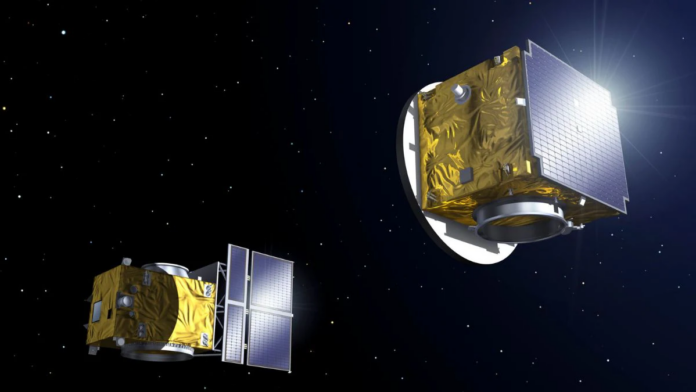On December 4, 2024, the Indian Space Research Organisation (ISRO) will launch the European Space Agency’s (ESA) Proba-3 mission, marking a significant milestone in international scientific collaboration. The mission, dedicated to studying the Sun’s corona, will use ISRO’s reliable Polar Satellite Launch Vehicle (PSLV) to lift off from Sriharikota. This partnership underscores India’s growing prominence in global space exploration and its critical role in advancing solar physics.

Proba-3’s Mission To Decode The Sun’s Outer Secrets
The Proba-3 mission is centered on the Sun’s corona, the outermost layer of the solar atmosphere, which boasts extreme temperatures exceeding 2 million degrees Fahrenheit. Understanding this region is essential for decoding solar phenomena like solar storms and winds, which have direct implications for space weather. These events can disrupt power grids, satellite communications, and navigation systems on Earth, making the study of the corona both scientifically and technologically significant.
Equipped with state-of-the-art instruments, Proba-3 aims to simulate solar eclipses to capture detailed observations of the corona. The mission features three cutting-edge tools:
- ASPIICS Coronagraph: This instrument creates artificial eclipses, enabling an unparalleled view of the Sun’s inner and outer corona.
- Digital Absolute Radiometer (DARA): This device measures total solar irradiance, a key factor in understanding the Sun’s influence on Earth’s climate.
- 3D Energetic Electron Spectrometer (3DEES): It tracks electron fluxes in Earth’s radiation belts, offering crucial data on space weather dynamics.
Innovative Technology Behind Proba-3
What sets Proba-3 apart is its pioneering use of precision formation flying. The mission employs two satellites—the 200 kg Occulter Spacecraft and the 340 kg Coronagraph Spacecraft—that work in tandem to create an artificial solar eclipse. The Occulter Spacecraft casts a shadow, allowing the Coronagraph Spacecraft to observe the Sun’s corona without interruptions.
This innovative alignment will provide scientists with uninterrupted views of the corona for up to six hours at a stretch, far surpassing the fleeting moments of natural solar eclipses. The data generated by Proba-3 is estimated to be equivalent to observing 50 solar eclipses annually, offering unparalleled insights into the Sun’s outer atmosphere.

Why Proba-3 Is A Groundbreaking Mission?
Proba-3’s capability to extend the observation window of the corona represents a paradigm shift in solar research. By using advanced coronagraph technology and precision satellite alignment, the mission overcomes limitations of conventional observation methods. This breakthrough is expected to enhance understanding of space weather phenomena, aiding in the development of predictive models that can mitigate their impact on Earth-based technologies.
Additionally, Proba-3’s findings will deepen our knowledge of the Sun’s magnetic field and its influence on solar wind patterns. This data is vital for advancing space weather forecasting, ensuring the safety of satellites, astronauts, and technological infrastructure.
ISRO’s Role: A Testament To India’s Space Prowess
ISRO’s selection as the launch provider for Proba-3 is a testament to its credibility in the global space industry. The PSLV, known for its reliability and cost-effectiveness, has become a go-to choice for international space agencies.
This collaboration with ESA highlights the growing trust in ISRO’s capabilities and its infrastructure’s robustness. The mission also offers Indian scientists exclusive access to Proba-3’s data, opening up new avenues for solar physics research.
Collaborative Opportunities With Aditya-L1
Proba-3’s launch aligns with India’s ongoing efforts in solar research, particularly through its Aditya-L1 mission, launched earlier to study the Sun. Collaborative studies integrating data from Proba-3 and Aditya-L1 are expected to yield groundbreaking discoveries in solar physics. This partnership will foster deeper cooperation between Indian and European scientists, strengthening the global research ecosystem.
Indian researchers will also benefit from opportunities to study solar phenomena using complementary data from both missions, enabling a holistic understanding of the Sun’s behavior and its effects on space weather.
Implications For Space Research And Technology
Proba-3’s successful deployment will underscore the importance of international collaboration in tackling complex scientific challenges. By combining ESA’s advanced mission design with ISRO’s reliable launch capabilities, the project demonstrates the power of partnership in pushing the boundaries of space exploration.
For India, Proba-3 marks another feather in ISRO’s cap, showcasing its ability to contribute meaningfully to global scientific endeavors. The mission also highlights the increasing role of precision satellite technologies, which have applications beyond solar research, including Earth observation, climate monitoring, and deep space exploration.
A Glimpse Into The Future Of Solar Physics
As Proba-3 prepares to take flight, the mission represents a leap forward in humanity’s quest to understand the Sun. Its groundbreaking approach to studying the corona has the potential to transform solar physics, offering new insights into the processes that govern our closest star.
The mission’s success will pave the way for future collaborations between ISRO and international agencies, setting a precedent for tackling larger and more complex scientific challenges. With Proba-3, the Sun’s secrets are closer to being unraveled, promising discoveries that could reshape our understanding of the universe.

